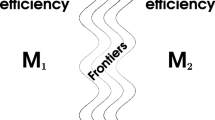Abstract
The computational power of membrane systems, in their different variants, can be studied by defining classes of problems that can be solved within given bounds on computation time or space, and comparing them with usual computational complexity classes related to the Turing Machine model. Here we will consider in particular membrane systems with active membranes (where new membranes can be created by division of existing membranes). The problems related to the definition of time/space complexity classes for membrane systems will be discussed, and the resulting hierarchy will be compared with the usual hierarchy of complexity classes, mainly through simulations of Turing Machines by (uniform families of) membrane systems with active membranes.
Access this chapter
Tax calculation will be finalised at checkout
Purchases are for personal use only
Preview
Unable to display preview. Download preview PDF.
Similar content being viewed by others
References
Alhazov, A., Leporati, A., Mauri, G., Porreca, A.E., Zandron, C.: The computational power of exponential-space P systems with active membranes. In: Martínez-del-Amor, M.A., Păun, Gh., Pérez-Hurtado, I., Romero-Campero, F.J. (eds.) Proceedings of the Tenth Brainstorming Week on Membrane Computing, vol. I, pp. 35–60. Fénix Editora (2012)
Alhazov, A., Leporati, A., Mauri, G., Porreca, A.E., Zandron, C.: Space complexity equivalence of P systems with active membranes and Turing machines. Theoretical Computer Science 529, 69–81 (2014)
Alhazov, A., Martín-Vide, C., Pan, L.: Solving a PSPACE-complete problem by recognizing P systems with restricted active membranes. Fundamenta Informaticae 58(2), 67–77 (2003)
Hemaspaandra, L.A., Ogihara, M.: The Complexity Theory Companion. Texts in Theoretical Computer Science. Springer (2002)
Leporati, A., Manzoni, L., Mauri, G., Porreca, A.E., Zandron, C.: Constant-space P systems with active membranes. Fundamenta Informaticae 134(1–2), 111–128 (2014)
Leporati, A., Manzoni, L., Mauri, G., Porreca, A.E., Zandron, C.: Membrane division, oracles, and the counting hierarchy. Fundamenta Informaticae 137, 1–15 (2015)
Leporati, A., Manzoni, L., Mauri, G., Porreca, A.E., Zandron, C.: Simulating elementary active membranes, with an application to the P conjecture. In: Gheorghe, M., Rozenberg, G., Salomaa, A., Sosík, P., Zandron, C. (eds.) CMC 2014. LNCS, vol. 8961, pp. 284–299. Springer, Heidelberg (2014)
Leporati, A., Mauri, G., Porreca, A.E., Zandron, C.: A gap in the space hierarchy of P systems with active membranes. Journal of Automata, Languages and Combinatorics 19(1–4), 173–184 (2014)
Mix Barrington, D.A., Immerman, N., Straubing, H.: On uniformity within NC\(^1\). Journal of Computer and System Sciences 41(3), 274–306 (1990)
Murphy, N., Woods, D.: The computational power of membrane systems under tight uniformity conditions. Natural Computing 10(1), 613–632 (2011)
Papadimitriou, C.H.: Computational Complexity. Addison-Wesley (1993)
Păun, Gh.: Computing with membranes. Journal of Computer and System Sciences 61(1), 108–143 (2000)
Păun, Gh.: P systems with active membranes: Attacking NP-complete problems. Journal of Automata, Languages and Combinatorics 6(1), 75–90 (2001)
Păun, Gh., Rozenberg, G., Salomaa, A. (eds.): The Oxford Handbook of Membrane Computing. Oxford University Press (2010)
Pérez-Jiménez, M.J., Romero-Jiménez, A., Sancho-Caparrini, F.: Complexity classes in models of cellular computing with membranes. Natural Computing 2(3), 265–284 (2003)
Porreca, A.E., Leporati, A., Mauri, G., Zandron, C.: Introducing a space complexity measure for P systems. International Journal of Computers, Communications & Control 4(3), 301–310 (2009)
Porreca, A.E., Leporati, A., Mauri, G., Zandron, C.: Elementary active membranes have the power of counting. International Journal of Natural Computing Research 2(3), 329–342 (2011)
Porreca, A.E., Leporati, A., Mauri, G., Zandron, C.: P systems with active membranes working in polynomial space. International Journal of Foundations of Computer Science 22(1), 65–73 (2011)
Porreca, A.E., Leporati, A., Mauri, G., Zandron, C.: P systems simulating oracle computations. In: Gheorghe, M., Păun, G., Rozenberg, G., Salomaa, A., Verlan, S. (eds.) CMC 2011. LNCS, vol. 7184, pp. 346–358. Springer, Heidelberg (2012)
Porreca, A.E., Leporati, A., Mauri, G., Zandron, C.: Sublinear-space P systems with active membranes. In: Csuhaj-Varjú, E., Gheorghe, M., Rozenberg, G., Salomaa, A., Vaszil, G. (eds.) CMC 2012. LNCS, vol. 7762, pp. 342–357. Springer, Heidelberg (2013)
Sosík, P.: The computational power of cell division in P systems: Beating down parallel computers? Natural Computing 2(3), 287–298 (2003)
Valsecchi, A., Porreca, A.E., Leporati, A., Mauri, G., Zandron, C.: An efficient simulation of polynomial-space turing machines by P systems with active membranes. In: Păun, G., Pérez-Jiménez, M.J., Riscos-Núñez, A., Rozenberg, G., Salomaa, A. (eds.) WMC 2009. LNCS, vol. 5957, pp. 461–478. Springer, Heidelberg (2010)
Zandron, C., Ferretti, C., Mauri, G.: Solving NP-complete problems using P systems with active membranes. In: Antoniou, I., Calude, C.S., Dinneen, M.J. (eds.) Unconventional Models of Computation, UMC 2000, Proceedings of the Second International Conference, pp. 289–301. Springer (2001)
Author information
Authors and Affiliations
Corresponding author
Editor information
Editors and Affiliations
Rights and permissions
Copyright information
© 2015 Springer International Publishing Switzerland
About this paper
Cite this paper
Mauri, G., Leporati, A., Manzoni, L., Porreca, A.E., Zandron, C. (2015). Complexity Classes for Membrane Systems: A Survey. In: Dediu, AH., Formenti, E., Martín-Vide, C., Truthe, B. (eds) Language and Automata Theory and Applications. LATA 2015. Lecture Notes in Computer Science(), vol 8977. Springer, Cham. https://doi.org/10.1007/978-3-319-15579-1_4
Download citation
DOI: https://doi.org/10.1007/978-3-319-15579-1_4
Published:
Publisher Name: Springer, Cham
Print ISBN: 978-3-319-15578-4
Online ISBN: 978-3-319-15579-1
eBook Packages: Computer ScienceComputer Science (R0)




